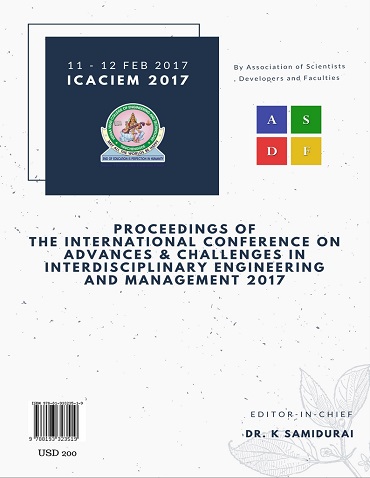- Publication Meta:Value
- Short Title:ICACIEM 2017
- Publisher:ASDF, India
- ISBN 13:978-81-933235-1-9
- ISBN 10:81-933235-1-3
- Language:English
- Type:Hard Bound - Printed Book
- Copyrights:ICACIEM Organizers / DCRC, London, UK
- Editor-in-Chief:Dr K Samidurai
- Conference Dates:11 - 12, February 2017
- Venue Country:Tiruchengode, India
- Submitted Papers:589
- Acceptance Rate:8.12%
- Website:www.icaciem.org
Welcome to ASDF Electronic Digital Library!
ICACIEM 2017
ICACIEM 2017
International Conference on Advances & Challenges in Interdisciplinary Engineering and Management 2017
Paper 007
Performance Analysis of Engine Cylinder Fins By Varying its Material and Geometry
S Mayakannan1
1Assistant Professor, Department of Mechanical Engineering, Vidyaa Vikas College of Engineering and Technology, Tiruchengode, India
Abstract
Heat transfer is a process variant in most heat generation methods, applying two wheeler heat conduction fins. IC engine fins Assemblies with in a reacting power transmission Mechanisms in this engine Assembly, which requires heat removal to ensure proper operation. This project investigates alternative cooling methods for an engine fins Assembly. IC engine fins Assembly temperatures by means of conduction cooling are needed for operating pressure. Enhanced design Stack Assembly designs which utilize fins, straight fins and internal cooling cavities are required to reduce or eliminate cooling. Steady state heat transfer finite element analyses are performed using ANSYS Workbench™ Version 14.5, utilizing 3-D models and heat transfer material properties of current engine fins Assemblies. ANSYS results from modified fins Assembly designs are then compared to baseline geometry ANSYS results. Baseline cooling analyses are performed to validate the FEA models. The baseline results show that the average temperature at the inner surface of the heat during normal operating conditions is approximately 23°C above the maximum technical limit of 423K. The baseline results are considered acceptable based upon the conservative boundary conditions used in the FEA model. Fins Stack Assemblies which utilize fin optimization varies of cross section with internal grooves like half circle, Triangular, Trapezoidal, Square cross section with sliding taper cut-out arrays are also analysed. Then comparing constant natural materials to take AL 6061, AL 200, CE17, CE17M it is considering to take thermal distribution analysis in transient conditions to solving problems it’s defined. An average temperature reduction of 150°C at the inner surfaces of the fins is achieved using fin arrays with a total additional surface area of 0.16 m 2 per Fins Stack Assembly. To consider forced convection to solving heat flux with distribution along the distance with respect to time to be calculating with result and discussed.
Keywords
Author's Profile
Author profile can be generated and linked through our partners World Book of Researchers. To include your profile online Click Here. After it is approved, please email to edlib @ asdf.res.in to create a link with all the papers.
e-AID
ICACIEM.2017.007
Cite this Article as Follows
S Mayakannan. Performance Analysis of Engine Cylinder Fins By Varying its Material and Geometry. International Conference on Advances & Challenges in Interdisciplinary Engineering and Management (2017): 04. Print.
© 2010 - by EDLIB .
All Rights Reserved.

